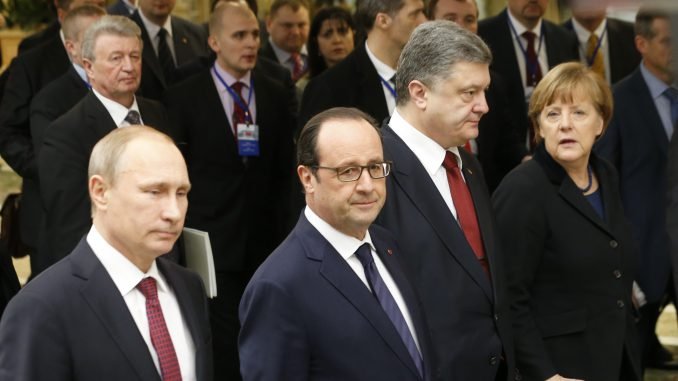
According to reports, the agreement includes a demilitarized zone, retraction of heavy weaponry, exchange of prisoners, constitutional reforms in Ukraine, elections in Donbass and resumed government payments to the separatist-controlled region. The ceasefire should begin after midnight on 15 February.
Commenting on the agreement, Lithuanian political analyst Nerijus Maliukevičius of Vilnius University says the devil’s in the details.
“It sounds like Minks No. 2, which in itself shows that the first try was not enough. Hence a grain of salt about Minsk No. 2 as well. Angela Merkel had said the same thing even before the meeting: general mistrust is widespread and devil’s in the details. As we have seen, agreements are easy to sign and announce, but the problem is to implement them. There was the first Minsk agreement [ceasefire deal reached last September], but, ironically, talks of ceasefire were drowned by sounds of gunfire,” according to Maliukevičius.
“I’d like to note that there was no joint announcement of the agreement, no press conference or discussion. When there is an agreement and all points have been worked out, it is not hard to go out together and say: we have an agreement and we will stick to it. When each leader speaks to their own press – Putin with the Russian media, others with their own – this means that there are diverging interpretations from the very start.”
Putin not to be trusted
Linas Kojala of Eastern Europe Studies Centre says that the demilitarized zone provision in the agreement essentially means that Russian soldiers and military equipment currently stationed in Ukraine will remain there.
AFP reports that during the talks in Minsk, some 50 Russian tanks crossed into the Ukrainian territory.
Kojala says that the point on pulling back heavy weaponry means, at best, that it will be moved several kilometres, but the Russian-Ukrainian border will remain unprotected, which will allow Russia to move troops and weapons to the country as freely as before.
He says that the ceasefire agreed upon in Minsk will merely mean that pro-Russian separatists will keep their guns loaded and will be able to resume attacks at any time they choose.
The ceasefire begins after midnight on Sunday. Until then, according to Kojala, “Russia is allowed, on advantageous terms, to do some more beating and draw a temporary demarcation line”.
Moscow keeps all the leverage it had before to use in future negotiations, while the Western side is foregoing its main leverage, i.e., the prospect of supplying arms to Ukraine. This option is no longer viable, since supposedly peace has been achieved.
“The worst-case scenario is if the European Union buys Putin’s smokescreen and starts talking about lifting sanctions without further moves (like disconnecting Russia from the SWIFT payment system) and thus de facto accepts Russia’s military methods of stopping Ukraine’s Western integration. The minimum we should seek now is to renew (or even expand) sanctions until Ukraine is in full control of its borders, until Russia withdraws its army and military equipment and until Kiev concludes decentralization in the form it finds acceptable,” Kojala says.
Very dangerous
Eastern Europe Studies Centre analyst Laurynas Kasčiūnas says that the key issue right now is how constitutional decentralization in Ukraine will be linked to Kiev taking back control of its borders. Ukraine’s President Petro Poroshenko has told the media that the country’s government did not agree to federalization or granting autonomy to the separatist-held territories.
The agreement document does mention decentralization of governing in Ukraine, but, Kasčiūnas insists, the exact word used is less important than how this provision will be implemented.
The document speaks of a constitutional reform in Ukraine, with a new constitution due to come into force by the end of 2015. Legislation granting special status to Donetsk and Luhansk regions are to be adopted by the end of this year.
“The essential point is what form this constitutional reform will take. And even if Poroshenko talks about decentralization rather than autonomy, it is important to know what content it carries. A federal state can very well be called centralized or unitary. This is an important point. I mean, if there is any linking of handing over border control to the course of the constitutional reform, its timing, then they [pro-Russia separatists] will always be able to exert pressure by saying that decentralization is faulty and does not go far enough,” according to Kasčiūnas.
“By controlling the border, the Russians will be able to control the substance of the decentralization,” the political analyst says.
The agreement document says that the Ukrainian government will have full control of the border after local elections are held in Donetsk and Luhansk and after completing constitutional reforms.
“Russia will be able to steer the constitutional reform, because it will be in control of the border. That’s the essence of the matter,” Kasčiūnas concludes.

Be the first to comment